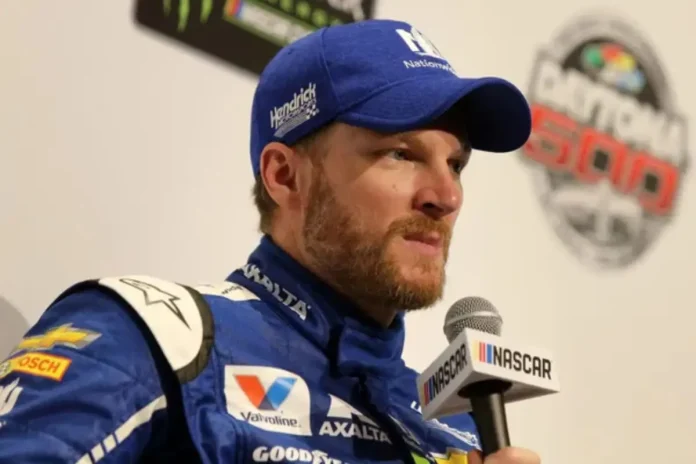Can NASCAR revive innovation without sacrificing driver safety? This question has been on the minds of fans and drivers alike. With the introduction of the Next-Gen cars, NASCAR has made bold moves towards cost-effectiveness and durability. However, Dale Earnhardt Jr. believes these changes may have gone too far. He says the new cars are “too tough,” raising concerns about whether safety is being prioritized at the cost of the sport’s excitement and performance. Will NASCAR find a balance between innovation and driver protection?
Key Highlights
- Dale Earnhardt Jr. criticized the Next-Gen car for prioritizing safety over speed and engineering creativity.
- He expressed concerns that overengineering has diminished NASCAR’s excitement and competitive edge.
- The Next-Gen car’s standardized components limit teams’ ability to innovate and customize designs.
- Dale Jr. advocates for balancing safety improvements with the sport’s historical emphasis on engineering prowess.
- The Next-Gen design’s perceived lack of performance has shifted focus away from NASCAR’s traditional racing appeal.
NASCAR’s Legacy of Innovation
How has NASCAR maintained its reputation as a crucible of technological advancement over the decades? The answer lies in its relentless drive towards innovation and its ability to adapt engineering marvels into practical applications. From its inception, NASCAR has been synonymous with the pursuit of speed and performance, serving as a fertile ground for pioneering technologies.
The introduction of disc brakes revolutionized racing safety and efficiency, marking a pivotal moment in motorsport history. These brakes, initially tested on the track, quickly found their way into mainstream automotive manufacturing, improving vehicle safety standards globally.
Moreover, NASCAR’s development of shock absorption zones has greatly improved crash survivability, setting a benchmark for automotive safety protocols. This innovation emphasized NASCAR’s commitment not just to speed, but also to the well-being of its drivers, ensuring that safety advancements kept pace with performance enhancements.
Furthermore, the incorporation of ethanol blends into racing fuel has illustrated NASCAR’s foresight in environmental stewardship, reflecting a paradigm shift towards sustainable fuel alternatives without compromising on power output.
These technological strides have not only cemented NASCAR’s role as a leader in motorsport innovation but have also rippled through the broader automotive industry, influencing design and safety standards.
However, the current discourse, as highlighted by Dale Earnhardt Jr., signals a shift in focus. The balance between cost-effectiveness and engineering ingenuity is under examination, challenging NASCAR to uphold its legacy of innovation while steering through the evolving landscape of motorsport technology.

Concerns with the Next-Gen Cars
NASCAR’s illustrious history of innovation now faces a formidable challenge with the introduction of the Next-Gen cars. Initially heralded as a groundbreaking leap towards competitiveness and cost-effectiveness, the Next-Gen car has encountered formidable criticism, particularly regarding safety. Although Dale Earnhardt Jr. originally acknowledged the car’s promising improvements, the 2022 season revealed considerable concerns, igniting a discourse between NASCAR officials and drivers.
The primary criticisms revolve around the car’s safety features. Remarkably, Kurt Busch and Alex Bowman both suffered concussions, raising alarms about the car’s crash resilience. NASCAR Cup driver Chase Briscoe echoed the sentiment that the current iteration lacks the robust safety profile of its predecessor, stating, “With the old car, you felt invincible.” This shift in driver perception emphasizes the underlying safety concerns that have emerged.
“The (car) needs to be as safe as it could possibly be. There’s no reason it shouldn’t be.”
“With the old car, you felt invincible, right? You could make these huge crashes and you’d get out and you’d be OK. And with this car you haven’t had this same feeling.” – Chase Briscoe
As NASCAR grapples with these safety concerns, balancing innovation with driver protection remains paramount. The Next-Gen car, while a step forward in some respects, must evolve to meet the rigorous safety expectations of its users.
Safety Adjustments and Dale Jr.’s Criticism
In the midst of ongoing examination of the Next-Gen car’s safety issues, NASCAR implemented considerable adjustments for the 2023 season, aiming to boost the vehicle’s durability and impact absorption capabilities. These modifications included improved resilience and groundbreaking rear clips designed to better withstand collisions.
While these changes were intended to address the safety concerns that had plagued the Next-Gen cars, they also sparked a contentious debate within the NASCAR community.
Dale Earnhardt Jr., a revered figure in the sport and a prominent voice among its critics, has been vocal about the trade-offs associated with these safety improvements. His critique centers on the notion that the pursuit of durability and cost-effectiveness has inadvertently compromised the very nature of NASCAR—its speed and engineering brilliance.
“This is my own opinion. NASCAR wanted to make a car that could handle impacts and so forth. But these pieces would relatively survive so that the owners wouldn’t be afforded the cost of replacing all these pieces week after week after week and so maybe in that attempt to try to make a car that’s more cost-effective and more durable. You know these pieces have been made too too tough.” – Dale Earnhardt Jr.
Earnhardt Jr.’s perspective echoes the sentiments of many passionate fans who fear that the adjustments, though well-intentioned, have come at the expense of the exhilaration and engineering innovation that define the sport.
Earnhardt Jr. articulated his concerns by highlighting the potential overengineering of the Next-Gen car components, designed to reduce repair costs for team owners by surviving impacts more robustly. He argues that this approach, while financially prudent, may have rendered the cars excessively rigid, diminishing the agility and high-speed performance that are hallmarks of NASCAR racing.

A Shift Away from Innovation
The evolution of safety measures in NASCAR, while addressing immediate concerns, has inadvertently led to a broader shift in the sport’s engineering landscape. With the introduction of the ‘Car of Tomorrow’ following the tragic loss of Dale Earnhardt Sr., NASCAR has initiated a course prioritizing safety and parity over the creative engineering that once defined the sport.
While these shifts have certainly saved lives, they have also curtailed the tradition of technological advancement that engineers and teams once celebrated.
Historically, NASCAR was a breeding ground for creativity, where mechanical maestros like Smokey Yunick could push the boundaries of what was possible. The sport was a canvas for testing cutting-edge aerodynamics, pioneering engine designs, and crafting original chassis.
However, the Next-Gen car represents a new era—one where standardized components and regulations have diminished the role of individualized brilliance.
- Creative engineering stifled: Teams now have less room to develop unique solutions.
- Regulations over innovation: A focus on leveling the playing field restricts advancements.
- Homogenization of vehicles: Standardized parts limit diversity in car design.
- Nostalgia for a golden era: Fans and engineers alike miss the ingenuity of past decades.
Hope for the Future of the Next-Gen Cars
Optimism surrounds the future of Next-Gen cars as stakeholders within NASCAR recognize the necessity of balancing safety with creativity. Dale Earnhardt Jr. and fans alike acknowledge that while the current iteration of these vehicles highlights durability, there is considerable potential for improvement. The path forward involves recalibrating weight and durability restrictions to reintegrate imaginative engineering and performance capabilities, a hallmark of NASCAR’s legacy.
Advancements in Next-Gen cars hinge on the tactical interplay between safety, cost control, and performance. NASCAR’s engineers are poised to revive the spirit of originality by exploring adjustments that honor the sport’s history while propelling it into a new era of competitiveness. Safety remains paramount, but it should not stifle the ingenuity that defines racing excellence. By allowing more experimental freedom, the sport can cultivate an environment where drivers can fully exploit the capabilities of their vehicles.
NASCAR’s commitment to evolving the Next-Gen car is vital. By addressing these pivotal factors, the sport can guarantee that vehicles remain resilient yet thrilling. This evolution promises to satisfy both the competitive desires of drivers and the expectations of fans. With calculated adjustments, NASCAR is positioned not only to preserve its storied past but to forge a dynamic future that welcomes the full spectrum of racing potential.

News in Brief: Can NASCAR Revive Innovation Without Sacrificing Driver Safety
The change to Next-Gen cars in NASCAR has sparked considerable debate regarding the balance between safety and innovation. Dale Earnhardt Jr.’s critique highlights concerns that these vehicles may prioritize safety improvements at the expense of speed and engineering ingenuity.
This shift raises questions about the sport’s future path and its commitment to technological advancement. Nonetheless, optimism remains as ongoing evaluations and modifications could potentially restore the equilibrium between safety and innovation, safeguarding NASCAR’s legacy of engineering excellence.
ALSO READ: Dale Earnhardt Jr. Reveals His 2025 Key West Trip Plans and Struggles to Convince Friends


